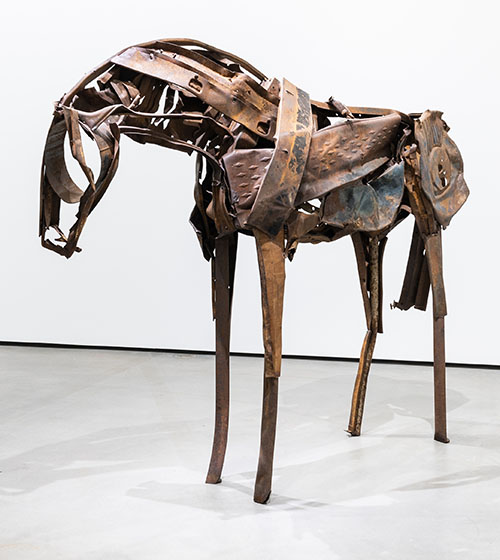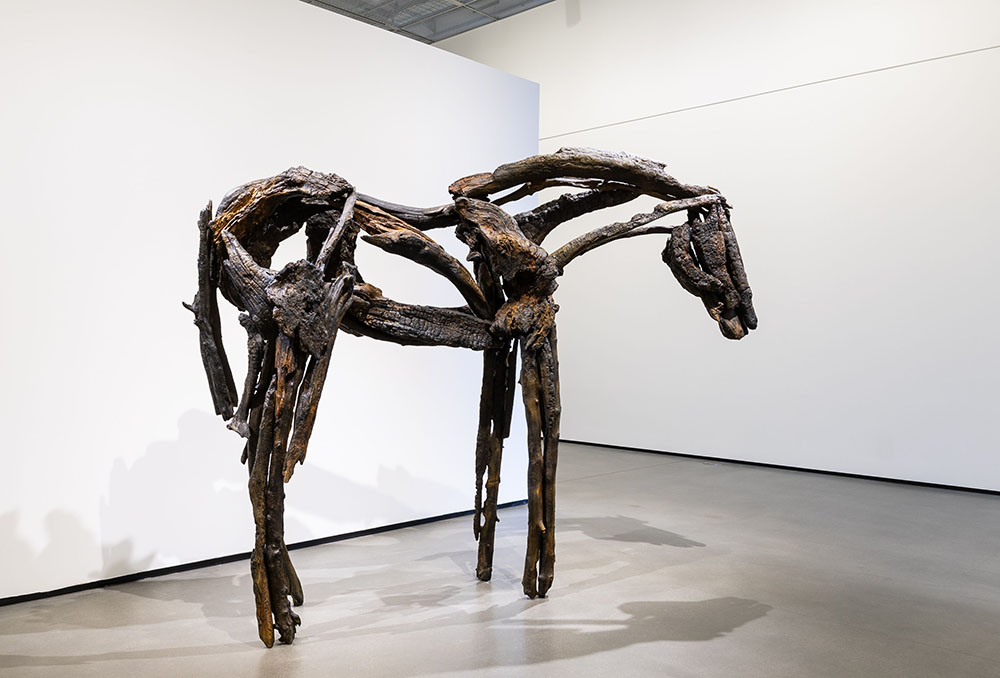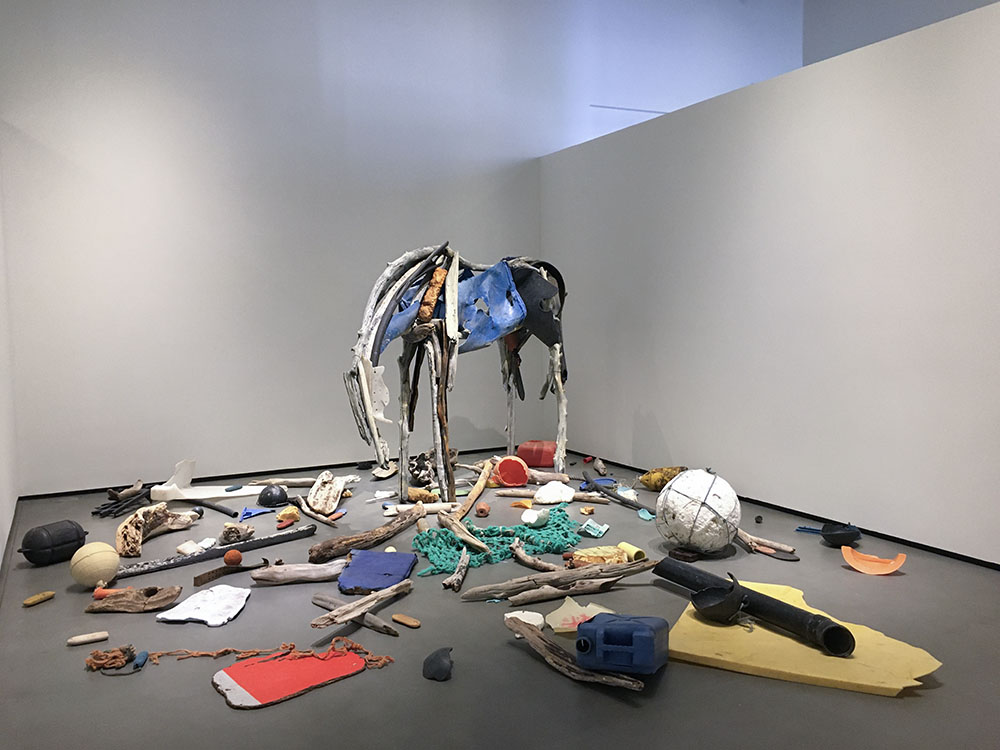by David M. Roth

For half a century, Deborah Butterfield, 74, has explored equine anatomy in ways never before seen. Whether made of branches, mud, sticks, scrap metal, rebar, driftwood, barbed wire or cast bronze, her sculptures speak as vividly of life as they do of death. Shot-through yet seemingly solid, these apparitional forms reveal an uncommon kinship with her subjects, one that, when yoked to a mastery of materials, yields a beguiling contradiction: abstract sculptures that look as convincing as any of the horses you might see grazing on the artist’s properties in Montana and Hawaii. The art-historical cliches of yore – monuments showing soldiers perched atop rearing war horses – are notably absent.
Given the ubiquity of Butterfield’s work in museums and public places, it’s easy to feel as if we know it. But do we? After watching the artist deliver a slide lecture last fall in which she showed nearly 150 images, I realized, perhaps for the first time, the degree to which she’s reinvented herself while remaining focused on a single subject. In the process, she’s somehow manages to sidestep Minimalism, Funk and Conceptualism, the dominant trends of the era from which she emerged, the early 1970s.

Deborah Butterfield: P.S. These are not horses, a highly telescoped survey at UC Davis’ Manetti Shem Museum organized by Rachel Teagle, the museum’s founding director, features 13 pieces culled from a career that began on this very campus. As museum shows go, it’s small. But it’s also, despite a spacious installation, extraordinarily dense. Consider the details of their construction and how they align to achieve the expressivity that has long been her trademark, and you’ll likely find yourself overwhelmed by the material transformations she enacts and the empathy they engender for their subjects. Appropriately, the show arrives prefaced by two works from her UC Davis mentor, William T. Wiley: a horse sculpture (The Hearings, 2007) and a poem (Re Questrian, 1981) whose final line, “P.S. These are not horses,” urges viewers to look beyond appearances – a challenge given how much there is to see and absorb.
The exhibition opens formally with two sculptures that look like they’d been pulled from the ruins of Pompeii. One stands, the other lies in repose, a classic Butterfield pairing of mares. To make them, the artist packed mud and straw into steel-and-wire armatures and surrounded them with upright sticks that could serve as funeral pyres. Constructed in 1978, they marked the artist’s shift from ceramics and plaster-based constructions to rawer, looser, abstract shapes whose primordial character captured the attention of the legendary dealer, Ivan Karp, who awarded Butterfield her first New York show at his gallery, OK Harris. A 1980 residency in Jerusalem accelerated her ascent. In bombed-out buildings, she found abundant scrap metal and fashioned it into sculptures that mixed positive and negative space in roughly equal measure, a mode of construction that would become her signature. Not long after, she and her husband, the sculptor John Buck, moved to a ranch in Montana, where they cleared the land of abandoned farm

machinery to make way for horses. Shapes similar to those form the basis of John (1984), Maluhia (1986), Uha ‘Ula ‘Ula (1986) and Rondo (1994), where painted and rusted metal scraps – cut, hammered, bent, twisted and torqued — combine to form images of what a horse might look like in the hands of, say, John Chamberlain, a sculptor whose junkyard-sourced pile-ups celebrate America’s post-industrial decline. In these, Butterfield drains the irony from Chamberlain’s proposition and twists it into its polar opposite: inanimate objects that approximate the character of living things. In so doing, she illuminates Wiley’s point that her sculptures, while ostensibly about horses, are, more than anything else, emblems of the entropic processes that overtake all things, inanimate or living.
As such, almost everything in Butterfield’s oeuvre hovers between those states, nowhere more poignantly than in bronze pieces cast from wood where the illusion of actual wood competes with the knowledge that they are metal masquerading as wood. The exhibition underscores that point with a display of bronze-cast wood scraps that you can handle and experience, for yourself, the discrepancies between appearance and reality. Bow Tie (2022-22) stands apart from the four other bronze works on view. Here, the illusion proferred is that of charred cinders, arrayed to leave a gaping hole at the center, a defining feature of the artist’s output since the early 1990s. Still, the animal’s essential grace remains intact, evidenced in the drooping head and lilting hindquarters. Moving through the exhibition, what becomes clear is that Butterfield can take any material of any shape and texture and establish equivalencies to the body language of animals.

Most she renders at or near life-size, but not all. Untitled (1980), which measures a mere 24 x 36 inches, is constructed of dry seaweed and driftwood woven in and around an invisible metal armature, affecting the look of exposed viscera. It’s exquisite. At the opposite end of the spectrum, Three Sorrows (quake, tsunami, meltdown from Gretel Ehrlich’s Facing the Wave) (2016), a room-sized installation, shows the figure of a horse looming over a mass of debris collected from the seashore, a reference to Ehrlich’s book of the same title about the tsunami that destroyed the Fukushima Daiichi nuclear power plant in 2011. While it doesn’t begin to convey the magnitude of that disaster, it does lay bare — through a profusion of nets, jerrycans, PVC tubing, styrofoam, netting, buoys, flotation devices and a length of blue plastic stretching the length of the horse’s digestive tract — the environmental threat posed by ocean-borne plastic waste. The exhibition also contains two examples of Butterfield’s early ceramic saddles, made while she was studying at UC Davis with Robert Arneson, and a collection of works by others (Martin Puryear, Jackie Windsor, Joan Brown, Roy de Forest, Arenson, Buck) she considers kindred spirits. Some, like Brown and de Forest, were also obsessed with animals. None, however, took their obsession as far as Butterfield. As a sculptor, she remains peerless.

# # #
“Deborah Butterfield: P.S. These are not horses” @ Manetti Shrem Museum of Art through June 24, 2024.
About the author: David M. Roth is the editor, publisher, and founder of Squarecylinder, where, since 2009, he has published over 400 reviews of Bay Area exhibitions. He was previously a contributor to Artweek and Art Ltd. and senior editor for art and culture at the Sacramento News & Review.

thank you David Roth- insightful. Also appreciated Jeff’s comment, “doing the same thing” – Definitely different every time- it’s up to the viewer to look!
Fantastic. Love her work.
Great review David. I see Debbie as a kind of Montana Morandi, seemingly doing the same thing endlessly but to profoundly different effect each time..
Nice observation and review of Debby Butterfield’s exquisite show! I think it’s a Must See show, especially for artists. Especially for those thinking Oh, I’ve seen her horses. You haven’t. There lies many a visual adventure in each individual piece.—and What material wonders! Wiley’s P.S. for the title is perfect.